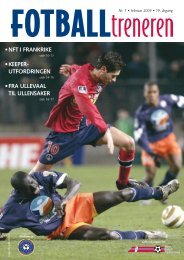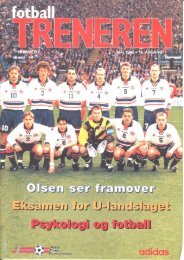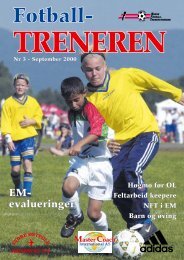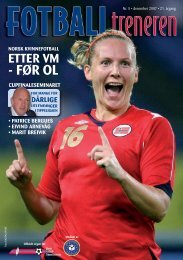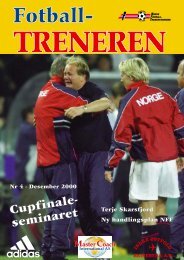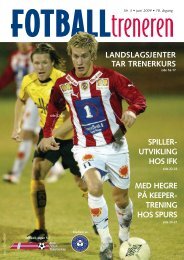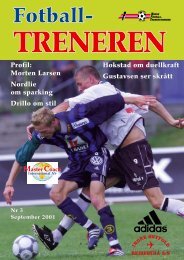KLAR LEKE - trenerforeningen.net
KLAR LEKE - trenerforeningen.net
KLAR LEKE - trenerforeningen.net
Create successful ePaper yourself
Turn your PDF publications into a flip-book with our unique Google optimized e-Paper software.
I denne artikkelen gir professor Harry Arne Solberg og professor Kjetil Haugen en analyse avsammenhengen mellom landslagenes prestasjoner og import/eksport av spillere over landegrensene.Artikkelen ble publisert i International Journal of Sport Marketing & Sponsorship -http://www.imrpublications.com/SM/IJSM/The international trade of players in Europeanclub football: Consequences for national teamsAv Harry Arne Solberg,Trondheim Business School, Sør-Trøndelag University Collegeog Kjetil K. Haugen,Department of Economics, Molde University CollegeAbstractThe international trade of players in European club football does not seem tohave had any negative effects on the national teams in the major leagues.Data presented in this article indicate a potentially positive effect for Englandand no effect for Spain, Italy and Germany. Contrary to this, the nationalteams in Norway, Greece and France seem to have benefited from exportingplayers to leagues of better quality than their own domestic leagues.Executive summaryThis case study analyses some of the effects of the international tradeof players in European club football and particularly the consequences fornational teams, both the importing and exporting nations. Analyses basedon FIFA rankings do not indicate that the growth in the import of foreignershas had a negative impact upon the national teams in the most successfulfootballing nations. This does not correspond with the idea that foreignplayers are to blame for the lack of success of a national team – a commonlyheld attitude among English football fans. Indeed, for England, the correlationcoefficient indicates that the opposite effect is more likely, namely thatthe national team has benefited from importing foreigners to the EnglishPremier League (EPL). During the 2006-07 season 42% of the EPL playerswere foreigners, assuming players from Scotland, Wales, Northern Irelandand Ireland be counted as ‘English’. If the latter group had been registeredas foreigners, the proportion would increase to 62%. In all of the top fourteams (Arsenal, Chelsea, Liverpool and Manchester United), the proportionof foreigners exceeded 50%.One explanation for this could be that foreign players have improved thelearning environment for the English players – i.e. for those who have notbeen displaced from their clubs. The import of foreigners has enabled themto play with, and against, more talented players than would otherwise havebeen possible. This, in turn, may have improved their quality as players.The analyses did not reveal any effects, either positive or negative, fornational teams in the other major European football nations, i.e. Spain, Italyand Germany. The data indicates that the national teams in Norway, Greeceand even France have benefited from exporting their best footballers to theleagues in the major nations, according to the FIFA ranking. The most likelyreason for this is that players from these nations have improved by movingto clubs operating in leagues where the learning environment is better thanat home. In turn, this may have benefited their respective national teams.IntroductionThe international trade of players in European club football is well established.It involves both import from other continents and the movementwithin Europe of European players. These developments have also influencedfrom which domestic clubs the national teams recruit their players.Until the mid-1990s the majority of European internationals played forclubs in their own domestic leagues. Since the start of the 21st century thispattern has been dramatically altered, with football players moving acrossborders in much the same way as other imports and exports.Many in the ‘football family’ have not been happy with this development,mainly through fear that foreigners will displace local talent and therebyreduce the quality of the national team. Sepp Blatter, FIFA president, hasargued for introducing an article in a new EU treaty to allow quotas on foreignfootballers. Trevor Brooking, the former England international, who by2007 was the English Football Association's director of development, hasexpressed similar views. Brooking suggests the growing number of foreignplayers in the Premier League has deprived domestic talent of first-teamfootball, which, in turn, has had a detrimental effect on England’s chancesof being successful in major tournaments (Slater, 2007): ”The national teamhas to be under threat – the numbers show that. I don't think you can underestimateit. It’s a major concern.”Norway’s national team coach, Åge Hareide, has expressed similar concerns:“The development is unfortunate. When young players are disallowedfrom playing, this will reduce the quality of the national team” (Vik &Mørseth, 2007).Grassroots football fans have also expressed their concerns. Among Englishfans, 59% feared that the influx of foreign stars to the Premier Leaguehad had a negative impact on the national side, according to The FootballFans Census (Payne, 2007). This corresponds with the results of a surveyconducted by Sky News, where the majority blamed the Premier League’sforeign legion as the major cause for England being dumped out of the EuropeanChampionships (Bowden, 2007).Michel Platini, UEFA president, has expressed a different view and insteadsupported the European Commission’s principle of free labour movementwithin the EU, which allows European soccer players to seek employmentwherever they want among the 27 nations (Associated Press, 2007).This case study focuses on the consequences of the developments discussedabove, with special attention given to national teams in both the importand the export nations. It provides an overview of developments sinceearly in the 1990s and goes on to discuss whether the import/export offootballers has had an effect on the quality of national football teams.TABLE 1 Percentage of foreign players in European football leaguesThe international trade of inputsIn this paper, football players are regarded as inputs to the production offootball games. The presence of foreigners in European club football is nota new phenomenon. For several decades clubs in Portugal and Spain haveimported Latin American players.Nevertheless, the rate of import was relatively moderate before the mid-1990s (see Tables 1 and 2). By the start of the 21st century, foreigners weremoving from all over the world, including from other European nations. Table3 shows the native countries of foreign players in the major five Europeanleagues. It reveals that English and German clubs recruited the largest contingentfrom other European nations; Italian and Spanish clubs preferredLatin Americans; and French clubs preferred Africans.As shown in Table 2, foreign players were in a majority in several clubs.The English Premier League (EPL) had the highest proportion (62%) duringthe 2006-07 season, assuming the players from Scotland, Wales, NorthernIreland, and Ireland were registered as non-English (Table 2). If the latterwere registered as English, the proportion was reduced to 43% (Table 1).Of the 10 European clubs with the highest proportion of foreign players,seven were English. In England, Italy and Spain, the top clubs had a higherproportion than other clubs – a pattern that was not replicated in France,Germany and the Netherlands.The most talented players have moved directly to the best clubs in the topfootballing nations. Those further down the ‘quality ladder’ have moved tolower-rated clubs in these leagues or to clubs outside the top five.34 FOTBALLtreneren - nr. 5 - 2009



